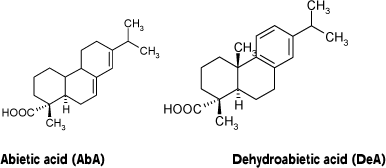Development of an analysis method for quantification of colophonium components in cosmetic products
1 Background
Colophonium (rosin) is a common cause of contact allergy and allergic contact dermatitis (1). According to the EU legislation a content of >1% colophonium in a product must be declared and the product must be labelled with warning according to R 43 (“May cause sensitisation by skin contact”). Colophonium is listed under the following CAS numbers: 8050-09-7, 8052-10-6 and 73138-82-6. According to the Cosmetics Directive (76/768/EØF) the component is listed on the INCI-list (Index on Cosmetic Ingredients) under the name ”Colophonium”, (EF. nr. 232-475-7) and there is no restriction for its application.
In clinical studies, significant concomitant positive patch test reactions have been observed involving colophonium and reactions to fragrance markers (fragrance mix and balsam of Peru) among consecutive patients (2-4). The concomitant test reactions described are best explained as the result of concomitant sensitization caused by simultaneous exposure to a wide variety of fragrance chemicals and colophonium components in products in everyday life (5). However, no extensive investigations regarding the content of colophonium in cosmetics have been preformed since no applicable analytical method exists that also consider the allergenic oxidized resin acids.
Colophonium is a resin obtained from different species of coniferous trees. It contains a complex mixture of resin acids (about 90%) and neutral substances (10%) which varies depending on species, recovery process and storage condition. The major acids are abietic acid (AbA) and dehydroabietic acid (DeA) (Figure 1) (1). Oxidized material is present in colophonium due to air exposure at normal handling and storage. Extensive studies have identified that oxidized compounds formed at air exposure originate mainly from AbA (6-9). While AbA itself is a weak allergen or non-allergenic, some of the oxidation products formed are allergens. One of the most prominent oxidation products is 15-hydroperoxyabietic acid, which is a potent allergen (10).
Colophonium is often modified or derivatized to obtain better technical properties. However, the modifications are usually interrupted when the desired technical properties are obtained leaving unmodified colophonium in the product. Both modified and unmodified colophonium can cause contact allergy. However, modified colophonium has been described to cause contact allergy due to content of unmodified colophonium (11).
Colophonium in unmodified and modified form is used in a range of different products and materials e.g. soldering fluxes, paper (paper size), paints, glues, adhesives, and also in cosmetics. The amount of unmodified colophonium in different products varies from 20% or more in some adhesives, paints and soldering fluxes for electronic assemblies to small traces in products containing mainly modified colophonium (12).
As colophonium is non-toxic, non-irritating and very sticky it is a perfect material to be used for application of cosmetics on the skin. Allergic contact dermatitis caused by colophonium in various cosmetic products such as eye shadows, rouge, lip preparations and mascaras is reported in literature. Colophonium has been detected also in mascaras marketed as “hypoallergenic” and the content of colophonium in the products investigated was enough to cause elicitations in sensitized individuals (13). Extensive reviews on the usage of colophonium have been presented during the years (6, 11, 14, 15).

Figure 1. The major resin acids in unmodified colophonium
Version 1.0 Marts 2009, © Danish Environmental Protection Agency